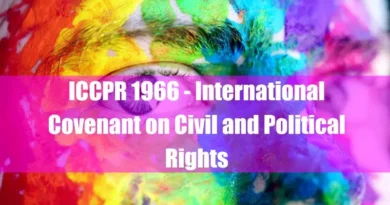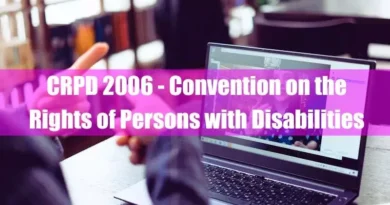ICERD 1965 – International Convention on the Elimination of All Forms of Racial Discrimination
Takeaways
| Key Points |
|---|
| The International Convention on the Elimination of All Forms of Racial Discrimination (ICERD) aims to eradicate racial discrimination and establish equality, defining racial discrimination in Article 1 as any act or policy that restricts human rights based on race, color, descent, or national or ethnic origin. |
| Its core principles, outlined in Articles 2 to 7, include prohibiting racial segregation, apartheid, and hate speech, requiring state parties to enact laws and policies to combat discrimination and promote racial equality. |
| Article 5 guarantees equality before the law and civil rights, including access to justice, education, employment, and public services, while Article 6 ensures effective legal remedies and reparations for victims of discrimination. |
| Additionally, Article 7 emphasizes cultural and educational efforts to foster tolerance and combat racial prejudice. |
| ICERD also establishes the Committee on the Elimination of Racial Discrimination (CERD) under Article 8, which monitors implementation through state reports (Article 9) and addresses complaints and disputes (Articles 11–14) to uphold justice and accountability. |
Introduction to ICERD 1965
Background and Adoption of ICERD
The International Convention on the Elimination of All Forms of Racial Discrimination (ICERD) stands as one of the most significant achievements in the global fight against racial discrimination. Adopted by the United Nations General Assembly on December 21, 1965, ICERD emerged in response to the increasing recognition of the need for a unified international approach to combat racial discrimination.
This period was marked by widespread civil rights movements, notably in the United States, and the ongoing struggle against apartheid in South Africa.
The atrocities of World War II and the Holocaust further underscored the urgent need to address racial discrimination at a global level.
ICERD became the first of the major human rights treaties to be adopted by the United Nations, paving the way for a series of international conventions to protect human rights.
The convention’s adoption reflected the collective will of the international community to eliminate racial discrimination in all its forms and ensure that all individuals, regardless of race, color, or ethnic origin, are treated equally under the law.
The Significance of December 21, 1965
December 21, 1965, is pivotal in international human rights law history. On this day, the UN General Assembly adopted Resolution 2106, which led to the establishment of ICERD. This convention was a landmark achievement, signifying the global community’s commitment to combating racial discrimination.
The adoption of ICERD also highlighted the growing consensus among nations that racial discrimination was not just a domestic issue but a global challenge that required international cooperation and legal frameworks to address effectively.
Core Objectives of ICERD
Definition of Racial Discrimination (Article 1)
Article 1 of ICERD provides a comprehensive definition of racial discrimination, identifying it as “any distinction, exclusion, restriction or preference based on race, color, descent, or national or ethnic origin which has the purpose or effect of nullifying or impairing the recognition, enjoyment or exercise, on an equal footing, of human rights and fundamental freedoms in the political, economic, social, cultural or any other field of public life.
This definition underscores the broad scope of the convention, which is designed to address overt acts of racial discrimination and practices that may have a discriminatory effect, even if not intended.
Goals and Principles Underlying the Convention
The overarching goal of ICERD is to eliminate racial discrimination in all its forms and manifestations. To achieve this, the convention establishes a legal framework that obligates state parties to take concrete measures to prevent and eradicate racial discrimination.
The principles underlying ICERD include equality before the law, the prohibition of racial segregation and apartheid, and the protection of individuals from racial discrimination in various aspects of public and private life.
By ratifying ICERD, state parties commit to enacting legislation and policies that align with these principles, ensuring that all individuals, regardless of their racial or ethnic background, are afforded equal rights and protections.

Key Provisions of the Convention
Measures to Eliminate Racial Discrimination (Article 2)
Article 2 of ICERD requires state parties to take immediate and effective measures to eliminate racial discrimination in all its forms. This includes enacting laws that prohibit racial discrimination, rescinding any laws or regulations that perpetuate racial discrimination, and taking affirmative actions to promote racial equality.
State parties are also obligated to condemn racial discrimination and pursue policies that promote understanding among all races.
Prohibition of Racial Segregation and Apartheid (Article 3)
Article 3 explicitly condemns racial segregation and apartheid, mandating state parties to prevent, prohibit, and eradicate such practices within their jurisdictions. This provision reflects the international community’s strong stance against the apartheid regime in South Africa, which was still in place at the time of ICERD’s adoption.
The inclusion of this article underscores the convention’s commitment to addressing the most extreme forms of racial discrimination.
Condemnation of Racial Hate Speech and Propaganda (Article 4)
Article 4 obligates state parties to condemn and criminalize all propaganda and organizations that promote racial hatred and discrimination. This includes making it an offense to disseminate ideas based on racial superiority or hatred and to incite acts of violence or discrimination against individuals based on their race or ethnic origin.
The article also calls for the prohibition of organizations that incite racial discrimination, further emphasizing the importance of combating hate speech and related activities.
Rights to Equality Before the Law and Civil Rights (Article 5)
Article 5 outlines the rights to equality before the law, emphasizing that all individuals should enjoy the same civil rights, political rights, and access to public services without discrimination based on race. This includes the right to equal treatment in the administration of justice, the right to security of persons, and the right to participate in elections.
The article also addresses economic, social, and cultural rights, such as the right to work, education, housing, and access to public places and services.
Protection Against Acts of Racial Discrimination (Article 6)
Article 6 requires state parties to ensure that everyone within their jurisdiction can access effective protection and remedies against racial discrimination. This includes providing the right to seek just and adequate reparation for any damage from discrimination.
The article emphasizes the importance of legal recourse and the role of national tribunals and institutions in safeguarding individuals’ rights.
Promotion of Understanding and Cultural Education (Article 7)
Article 7 focuses on the need for education and cultural programs to combat racial prejudices and promote understanding, tolerance, and friendship among nations and racial groups.
It calls on state parties to take measures in the fields of teaching, education, culture, and information to advance the goals of the convention and to foster an environment where racial discrimination is universally condemned.

The Role of the Committee on the Elimination of Racial Discrimination (CERD)
Formation and Functions of CERD (Article 8)
Article 8 of ICERD establishes the Committee on the Elimination of Racial Discrimination (CERD), a body of independent experts tasked with monitoring state parties’ implementation of the convention. The committee consists of 18 members elected by state parties who serve in their personal capacities.
CERD’s primary function is to review reports submitted by state parties on the measures they have taken to comply with the convention and to make recommendations on improving their efforts to eliminate racial discrimination.
Reporting Obligations of State Parties (Article 9)
Under Article 9, state parties must submit periodic reports to CERD detailing the legislative, judicial, and administrative measures they have taken to implement the provisions of ICERD. These reports provide the basis for the committee’s review and recommendations.
State parties must submit their initial report within one year of ratifying the convention and subsequent reports every two years after that. The reporting process allows CERD to assess the progress made by state parties in combating racial discrimination and to identify areas where further action is needed.
Procedures for Handling Complaints and Disputes (Articles 11-14)
Articles 11 to 14 outline the procedures for handling complaints and disputes under ICERD. These provisions allow state parties to complain against others for violating the convention. The committee may also receive complaints from individuals or groups who allege that their rights under the convention have been violated, provided that the state party concerned has recognized the competence of CERD to consider such complaints.
The committee’s role in resolving disputes and addressing individual complaints is crucial for ensuring that the convention is enforced effectively and that victims of racial discrimination have access to justice.

Impact and Implementation
Ratification and Implementation by Member States
Since its adoption, ICERD has been ratified by 182 states, making it one of the most widely accepted human rights treaties. Ratification indicates a state’s commitment to eliminating racial discrimination within its jurisdiction. State parties must align their national laws and policies with ICERD’s provisions upon ratification.
This process includes enacting legislation prohibiting racial discrimination, establishing institutions to monitor compliance, and ensuring that individuals can access effective legal remedies.
The impact of ICERD’s ratification has been significant in many countries. In South Africa, for example, the convention provided a legal framework to dismantle apartheid and establish a system based on equality. In the United States, ICERD has influenced the development of civil rights laws that address racial discrimination in various sectors, including employment, housing, and education.
Case Studies of CERD’s Role in Addressing Racial Discrimination
CERD has been pivotal in addressing racial discrimination by reviewing state party reports and handling complaints. For example, CERD has issued recommendations to Brazil, urging stronger measures to protect the rights of Afro-descendants and indigenous peoples. In Australia, CERD has addressed the treatment of Aboriginal and Torres Strait Islander peoples, emphasizing the need for greater legal protections against discrimination.
A notable case involved CERD’s review of France’s policies on Roma communities. CERD expressed concern over the forced eviction of Roma people and inadequate housing and social services.
The committee’s recommendations increased scrutiny and pressure on the French government to improve its treatment of Roma communities, aligning its policies with international human rights standards.
General Recommendations Issued by CERD
CERD regularly issues general recommendations to clarify state parties’ obligations under ICERD and address emerging issues. These recommendations guide states on effectively implementing the convention’s provisions in various contexts. For instance, General Recommendation No. 35 addresses combating racist hate speech, emphasizing the need for legislation that prohibits such speech while balancing the right to freedom of expression.
Other recommendations focus on the rights of indigenous peoples, the treatment of non-citizens, and the impact of racial discrimination on women.

ICERD as a Living Instrument
Evolution of the Convention’s Application
ICERD is often regarded as a “living instrument,” meaning it is applied and interpreted in response to contemporary challenges. As new forms of racial discrimination have surfaced, ICERD has remained relevant by adapting its provisions to address them.
One example is the rise of online hate speech and cyber-racism, which were not anticipated during ICERD’s adoption. CERD has evolved its interpretation to ensure member states are prepared to tackle these modern challenges.
Over time, CERD has also expanded its focus to include how racial discrimination intersects with other forms of discrimination, such as those based on gender, disability, or migration status. This approach acknowledges that discrimination often does not occur in isolation but is compounded by other social factors, necessitating comprehensive strategies to address these overlapping issues.
Adapting to Contemporary Challenges in Combating Racism
As global demographics shift and societies grow more diverse, the fight against racial discrimination becomes increasingly complex. ICERD’s provisions have been applied to new issues like xenophobia, discrimination against refugees, and the rise of nationalist movements.
CERD has issued guidance encouraging state parties to strengthen legal frameworks, enhance data collection on racial discrimination, and promote public education to foster tolerance.
The COVID-19 pandemic highlighted existing racial inequalities, disproportionately affecting racial and ethnic minorities. CERD responded by emphasizing the need for inclusive pandemic responses that do not exacerbate these inequalities.
The committee urged governments to ensure that their actions during the pandemic address the needs of all populations fairly.
Challenges and Criticisms
ICERD has faced criticism for being overly general, making it challenging for states to implement its provisions effectively. Critics argue that the convention places too much emphasis on individual acts of discrimination while neglecting systemic and structural racism, which are fundamental causes of inequality.
Another significant criticism is the absence of strong enforcement mechanisms within ICERD. While CERD oversees compliance, its recommendations lack legally binding force, limiting their impact. This has sparked calls for more robust measures to ensure that states fulfill their obligations under the convention.
Enforcing ICERD remains difficult, especially in regions where racial discrimination is deeply entrenched. Some states are slow to enact necessary reforms, often due to political resistance. The rise of nationalist movements and racist rhetoric globally further complicates progress. Additionally, CERD struggles with limited resources as its workload increases, highlighting the need for better financial and human support to maintain the effectiveness of ICERD.
Conclusion
ICERD remains a pivotal tool in the ongoing global battle against racial discrimination. Despite changes in how discrimination manifests, the convention’s principles provide a solid foundation for promoting equality and justice.
Its ability to adapt to contemporary challenges, such as digital hate speech and intersectional discrimination, underscores its continued importance in international human rights law.
For racial equality to progress, the global community must fully commit to implementing ICERD’s provisions. The convention’s framework is comprehensive, but its success hinges on active enforcement by state parties.
Enhancing international collaboration, strengthening CERD’s capacity, and fostering education on equality is critical to realizing the convention’s objectives.
As the world grapples with persistent racial inequalities, ICERD’s role remains vital in steering international efforts. Adhering to its principles is key to building a more just and inclusive global society.
FAQ
What is the International Convention on the Elimination of All Forms of Racial Discrimination (ICERD) 1965?
Adopted by the United Nations in 1965, ICERD is a treaty that commits member states to eliminate racial discrimination and promote understanding among all races. It mandates prohibiting discriminatory practices and promoting equality in various sectors, including education and employment.
How does ICERD define racial discrimination?
ICERD defines racial discrimination as any distinction, exclusion, restriction, or preference based on race, color, descent, or national or ethnic origin that impairs the recognition or exercise of human rights and fundamental freedoms on an equal footing.
What obligations do states have under ICERD?
States parties are obligated to pursue policies that eliminate racial discrimination in all its forms. This includes ensuring that public authorities and institutions do not engage in discrimination, prohibiting and bringing to an end racial discrimination by any persons or organizations, and taking affirmative action measures as needed.
Does ICERD address hate speech and racist organizations?
Yes, Article 4 of ICERD condemns all propaganda and organizations based on ideas of racial superiority. States parties are required to act to eradicate all incitement to discrimination and prohibit the dissemination of ideas based on racial superiority, as well as acts of violence or incitement to violence against any race.
How does ICERD relate to apartheid?
Article 3 of ICERD specifically condemns apartheid and obligates states parties to prevent, prohibit, and eradicate all such practices within their territories. This underscores the international community’s commitment to eliminating institutionalized racial segregation and discrimination.
What rights are protected under ICERD?
ICERD guarantees equality before the law in the enjoyment of various rights, including political rights, freedom of movement, the right to nationality, the right to marriage and choice of spouse, property rights, freedom of thought and religion, and economic, social, and cultural rights.
How does ICERD ensure compliance by states parties?
ICERD established the Committee on the Elimination of Racial Discrimination, which monitors implementation by reviewing reports submitted by states parties. The Committee can make recommendations and consider individual complaints if the state recognizes its competence.
Can individuals file complaints under ICERD?
Yes, under Article 14, individuals or groups who claim their rights under the Convention have been violated can file complaints to the Committee, provided their country has recognized the Committee’s competence and domestic remedies have been exhausted.
How does ICERD address education and public awareness?
Article 7 obligates states parties to adopt measures in education and teaching to combat prejudices that lead to racial discrimination. This includes promoting understanding, tolerance, and friendship among nations and racial or ethnic groups.
How many countries are parties to ICERD?
As of July 2020, ICERD has 88 signatories and 182 parties, indicating a widespread international commitment to eliminating racial discrimination.









